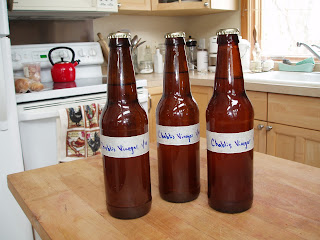Yesterday we harvested the rest of the hops - so much more than last year! We tried to restrict the Cascade to 3 vines each but it was just so vigorous and took over the arbor at the top of the deck, 2.5 stories up. The Willamette was more sedate but we got two 1-gallon bags of that variety. We'll have closer to a trash bag full of Cascade... now to think of a brew with our hops and honey.
This photo shows Mole, one of the new Silver Laced Wyandottes, with Mongo in the background. We had to move them outside early but they get along fairly well with the older Rhode Island Reds (Whitey Ford to the left). The Sussex and Australorps are outside now too, but they are still getting used to the great wide world and are a bit flightier. Also more aggressive. We've had second thoughts about mixing breeds, but time will tell how they integrate.
This is a photo of our first egg from the young hens! They are much smaller for the first month or so and we're still debating whether to use a light in the coop. With daylight decreasing each day I'm worried they'll stop laying entirely for the fall and winter, just when they're at the perfect laying age. On the other hand, I like the idea of the girls keeping to a natural seasonal rhythm, just as I do. Something to think about.
That beautiful orange pot is our new dutch oven. It has seen a lot of use in the 4 weeks we've had it: pickle juice, LOTS of applesauce, two batch of mac 'n cheese, and of course, crusty no-knead bread. I can't believe we lived without one for so long. Definitely our favorite piece of cookware.
And a preview of the fall crops. Unfortunately the hoop house isn't quite so photogenic right now because the hens found their way inside - pretty tragic actually. But we've got some fall greens and radishes, as well as carrots, beets, daikons, and quite a few peppers, tomatoes and eggplants still on the vine. At home we've started the coldframes but might be a little late this year. More to come in future posts!




























